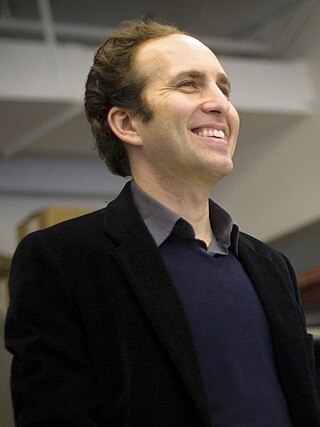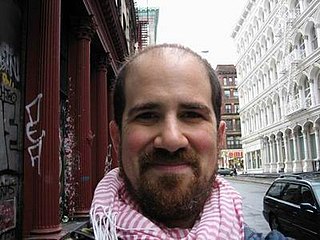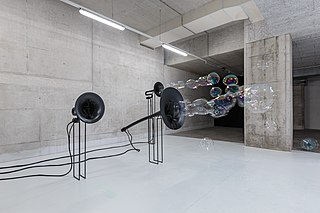Related Research Articles

ARD is a joint organisation of Germany's regional public-service broadcasters. It was founded in 1950 in West Germany to represent the common interests of the new, decentralised, post-war broadcasting services – in particular the introduction of a joint television network.

Thomas Köner is a multimedia artist whose main interest lies in combining visual and auditory experiences. The BBC, in a review of Köner's work in 1997, calls him a "media artist," one who works between installation, sound art, ambient music and as one half of Porter Ricks dub techno. A noted characteristics of Köner's dark ambient style are low drones and static soundscapes evocative of desolate, Arctic places.

Alejandra and Aeron, also known as Bergman and Salinas, are Alejandra Salinas and Aeron Bergman, artists living in Detroit, Michigan. They are an artist duo producing media, performance, internet, sound and sculptural works and objects in an interdisciplinary, conceptual yet socially engaged practice.

Scott Snibbe is an interactive media artist, entrepreneur, and meditation instructor who is currently the host of A Skeptic's Path to Enlightenment meditation podcast. He has collaborated with other artists and musicians, including Björk on her interactive “app album” Björk: Biophilia that was acquired by New York's MoMA as the first downloadable app in the museum's collection. Between 2000 and 2013 he founded several companies, including Eyegroove, which was acquired by Facebook in 2016. Early in his career, Snibbe was one of the developers of After Effects.
Daniel Rozin is an Israeli-American artist working in the area of interactive digital art. As an interactive artist Rozin creates installations and sculptures that have the unique ability to change and respond to the presence and point of view of the viewer. In many cases the viewer becomes the contents of the piece and in others the viewer is invited to take an active role in the creation of the piece.
Richard Chartier is a sound/installation artist and graphic designer from the United States. He works in reductionist microsound electronic music, a form of extreme minimalism characterised by quiet and sparse sound.

Golan Levin is an American new media artist, composer, performer and engineer interested in developing artifacts and events which explore supple new modes of reactive expression.

Zachary Lieberman is an American new media artist, designer, computer programmer, and educator.

Michael Mandiberg is an American artist, programmer, designer and educator.

Christoph Korn is a German audio and media artist working with diverse artistic forms of expression: Composition and Installation, video, text, net art and improvisation.
Antoine Schmitt is a French contemporary artist, programming engineer and designer.

Aram Bartholl is a Berlin-based conceptual artist known for his examination of the relationship between the digital and physical world. His works often deal with anonymity and privacy. Aram Bartholl is currently Professor for art with digital media at HAW Hamburg.

Marie Sester is a French-American decades-long artist, and current PhD student studying the nature of consciousness. Her artwork involves cross-disciplinary practices and experimental systems in Interactive Art using tracking technologies, light, audio, video, and biofeedback, focusing on social awareness and the responsibility of personal commitments. Her PhD work is in Integral and Transpersonal Psychology focusing on connectedness, expansiveness, and presence.
Paolo Cirio is a conceptual artist, hacktivist and cultural critic.

Benton C Bainbridge is an American artist known for new media art including single channel video, interactive artworks, immersive installations and live visual performances with custom digital, analog and optical systems of his own design.
Kurt Hentschlager, or Hentschläger is a New York-based Austrian artist who creates audiovisual installations and performances. Between 1992 and 2003, he worked in a duo called Granular-Synthesis.

Anouk De Clercq is a Belgian multimedia artist.

Black Hole Horizon is a kinetic sculpture created by Swiss-German artist Thom Kubli between the years 2012 and 2015.
Sebastian Wolf is a German Media artist and designer. In his work he explores "novel technologies and their inherent aesthetic and emotional potential" through interactive kinetic and light installations, usually incorporating natural elements. He lives and works in Berlin.
References
- ↑ "Planet Jazz". Discogs (in German). Retrieved 2017-11-05.
- ↑ "True Frequencies". Discogs. Retrieved 2017-11-05.
- ↑ "Deterritoriale Schlingen | transmediale". transmediale.de (in German). Retrieved 2017-11-05.
- ↑ "VIRILIO CUBES". Vimeo. Retrieved 2017-11-05.
- 1 2 3 "Exhibitions - New Museum Digital Archive". New Museum Digital Archive. Retrieved 2017-11-05.
- 1 2 "Tom Kubli : FLOAT! Thinktank 21 : Dancing on the Ceiling: Art & Zero Gravity curated by Kathleen Forde : EMPAC Curtis R. Priem Experimental Media and Performing Arts Center : Troy, NY USA". zerogravity.empac.rpi.edu. Retrieved 2017-11-05.
- ↑ "Black Hole Horizon - Radical Atoms". Radical Atoms. 2016-08-01. Retrieved 2017-11-05.
- ↑ "Black Hole Horizon at Ars Electronica 2016". Vimeo. Retrieved 2017-11-05.
- ↑ "Black Hole Horizon via FILE-Festival".
- ↑ "Interview with Thom Kubli : Dancing on the Ceiling: Art & Zero Gravity curated by Kathleen Forde : EMPAC Curtis R. Priem Experimental Media and Performing Arts Center : Troy, NY USA". zerogravity.empac.rpi.edu. Retrieved 2017-11-05.
- ↑ "The Complete Collection: Marian Spore". Rhizome. Retrieved 2017-11-05.
- ↑ "ARD-Hörspieldatenbank". hoerspiele.dra.de. Retrieved 2017-11-05.
- ↑ patricia. "Record Attempt — LABoral Centro de Arte y Creación Industrial" . Retrieved 2017-11-05.
- ↑ "Thom Kubli / Record Attempt". Vimeo. Retrieved 2017-11-05.
- ↑ Johnson, Ken (2005-07-08). "Art in Review; What Sound Does a Color Make?". The New York Times. ISSN 0362-4331 . Retrieved 2017-11-05.
- ↑ "Thom Kubli - Collaborators - Independent Curators International". curatorsintl.org. Retrieved 2017-11-05.
- ↑ "Tom Kubli". kunstverein-ingolstadts Webseite! (in German). Retrieved 2017-11-05.
- ↑ "Thom Kubli". Experimental Media and Performing Arts Center (EMPAC). Retrieved 2017-11-05.
- ↑ "Kubli - Philipp von Rosen Galerie". www.philippvonrosen.com (in German). Retrieved 2017-11-05.
- ↑ "FILE SÃO PAULO 2017 – Artist: Thom Kubli – FILE". FILE. Retrieved 2017-11-05.
- ↑ "The Lowry". www.thelowry.com. Retrieved 2017-11-05.
- ↑ "Black Hole Horizon - Radical Atoms". Radical Atoms (in German). 2016-08-01. Retrieved 2017-11-05.
- ↑ "Thom Kubli | Children of the Convolution (2016) | Artsy". www.artsy.net. Retrieved 2017-11-05.
- ↑ "Stadt Marl-News - Einzelansicht". www.marl.de (in German). Retrieved 2017-11-05.
- ↑ mromalde. "Thom Kubli — LABoral Centro de Arte y Creación Industrial". www.laboralcentrodearte.org. Retrieved 2017-11-05.
- ↑ "Alan Licht - Inside Out". www.alanlicht.com. Retrieved 2017-11-05.
- ↑ "Sonic Acts XII:the Cinematic Experience | Digicult | Digital Art, Design and Culture". Digicult | Digital Art, Design and Culture. 2008-01-29. Retrieved 2017-11-05.
- ↑ "What sound does a color make via Eyebeam". Archived from the original on 2017-10-13.
- ↑ "Stationsraum für assimilativen Zahlwitz | transmediale". transmediale.de. Retrieved 2017-11-05.
- ↑ "ARD-Hörspieldatenbank". hoerspiele.dra.de. Retrieved 2017-11-05.
- ↑ Ruhr, Theater an der. "Die Wupper - Eine Performance - Theater an der Ruhr". www.theater-an-der-ruhr.de. Retrieved 2017-11-05.
- ↑ "ARD-Hörspieldatenbank". hoerspiele.dra.de. Retrieved 2017-11-05.
- ↑ "ARD-Hörspieldatenbank". hoerspiele.dra.de. Retrieved 2017-11-05.
- ↑ "ARD-Hörspieldatenbank". hoerspiele.dra.de. Retrieved 2017-11-05.
- ↑ Mayr, Johannes (2013-03-20), "Cici Letters" von Thom Kubli und Benjamin Tillig (in Swiss High German), Schweizer Radio und Fernsehen SRF, retrieved 2017-11-05
- ↑ "ARD-Hörspieldatenbank". hoerspiele.dra.de. Retrieved 2017-11-05.
- ↑ "ARD-Hörspieldatenbank". hoerspiele.dra.de. Retrieved 2017-11-05.
- ↑ "ARD-Hörspieldatenbank". hoerspiele.dra.de. Retrieved 2017-11-05.